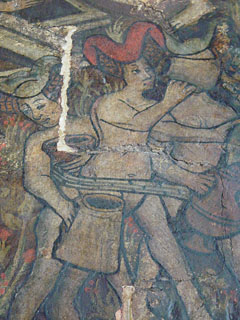Long obscured by the whitewash of the Reformation, then buried beneath the discoloured varnish of a botched nineteenth-century restoration job, a rare and extraordinary medieval painting of The Last Judgement has been uncovered in the church of Holy Trinity, Coventry. As these first published pictures of the newly restored work show, it is a vigorously scary depiction of the moment when the Last Trump shall sound, painted in a crude but bold style and teeming with fascinating and unusual detail. It is hard to think of a more potent relic of English fifteenth-century dread. The picture must be counted one of the most important discoveries to have been made in the field of medieval art.
The so-called “Coventry Doom”, painted above the chancel arch of Holy Trinity and therefore dominating the nave of the church, shows the monumental figure of Christ passing judgement on the souls of all humanity. The blessed, on his right-hand side, make their orderly way towards the gate of heaven, which lies at the top of a flight of stone steps. The damned, on his left, tumble towards hell, envisaged as the snarling maw of a grotesque beast. Some figures already cower within its fanged cavern, their naked bodies licked by flames of hellfire, rendered as a pleasingly regular grille of serpentine lines in bright red pigment. The costume worn by some of the men and women rising from the dead, in particular the heart-shaped horned head-dresses worn by three ale-serving wenches in the right portion of the picture, suggest that the work was painted in the early 1430s.  Although scenes of the Last Judgement were common in medieval English churches, the people of Coventry had good cause to order such a cautionary picture for one of their principal religious buildings at this particular moment. An...
Although scenes of the Last Judgement were common in medieval English churches, the people of Coventry had good cause to order such a cautionary picture for one of their principal religious buildings at this particular moment. An...


